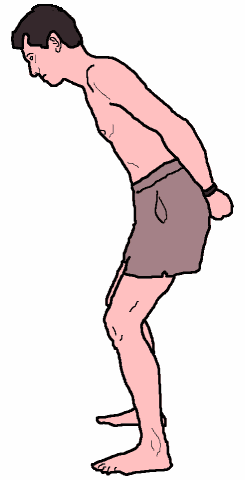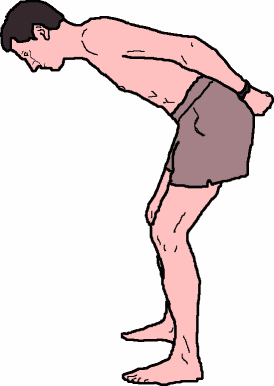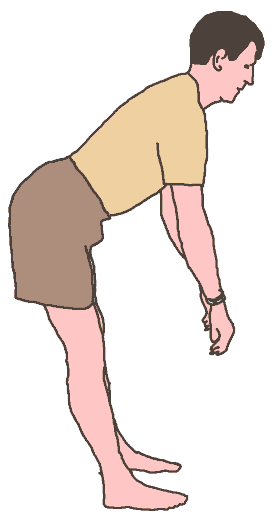|
|
|---|
The Bent Knee Bow - Start Position:-
- Stand in the position of mechanical advantage with fists pressing into buttocks
(diagram on left). The fist will enable you to monitor Gluteal engagment and
straightness of back.
- Zip and hollow, and gently apply the scapular anchors.
The Bent Knee Bow - Action:-
- Breathe in and (breathing out): bend at the hips as far as you can comfortably go.
- Breathe in and (breathing out): engage the Gluteus maximus and return to the position of
mechanical advantage.
- Repeat 5 to 10 times
- (To get your body even lower, bend your knees more at the start, and maintain the bent knees).
Watch Points
- Your back does not change its shape! - the movment is at the hips!
- Your head and neck do not change their shape!
- The zip and hollow stays on all the time.
- The knees must remain bent - at least as much as in the above diagram!
- Initially don't overdo it! - Working the Glutes and hamstrings over their longer range is a
surprisingly demanding workout!
(Scroll right>>>...)
|
| The Bent Knee Bow:
Use this basic movment pattern for strengthening your back, and also for learning the
correct way to "bend down"! |
Start Position:-
 |
Action:-
 |
The Straight Leg "Bend Down" with Return:-
Avoid these faulty everyday movement patterns! |

|

|
|
What it does:-
In anatomical terms:-
- Works the Gluteus maximus and the hamstrings over their longer range of their
motion, thereby strengthening them.
- Promotes strength and endurance in the erector spinae muscles in the back.
Endurance of these muscles is a major predictive factor as to whether you
will experience back pain.
In Posture-Movement Terms:-
- Maintains the whole spine from hip to head well within its "strong middle range"
- next time you pull a pan out of the kitchen cupboard,
or tie your shoe laces, you will
be keeping your back safe within its middle range!
Reference
- Shirley A Sahrman: "Movement Impairment Syndromes" Publ. Mosby, 2002
ISBN 0-8016-7205-8
- John Gray: Your Guide to the Alexander Technique
Publ. Victor Gollancz Ltd. London 1990 ISBN 0-575-04799-2
- B I Kodisch: Back Pain Solutions: How to help Yourself with Posture-Movement
Therapy and Education Publ.Extensional Publ. Pasadena, Ca 2001 ISBN 0-9700664-5-7
- Bruce Thomson: Engage Gluteus maximus!
© Bruce Thomson, EasyVigour Project
scroll up^^^^....)
|